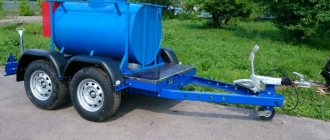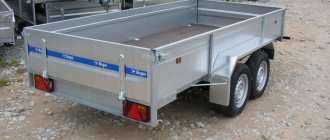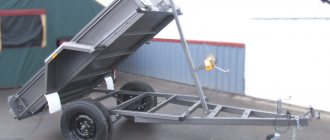A homemade trailer-trolley for transporting a car on a rigid coupling was assembled by Wild Tatar. A photo and video review of the design is presented below. It is better and more reliable to transport a broken car to a repair site using a rigid hitch, and a rolling trailer was invented specifically for this purpose.
The principle of rolling is that the transported vehicle runs over it, and the wheels are fixed in special openings welded from a square pipe and additionally tightened with a stripper.
The wheels of a dolly trailer steer and follow the path of the tractor, this is done thanks to steering rods installed and connected into a single structure with the trailer drawbar.
The maximum width along the outer rim of the wheels is 1840 mm. Weight 96 kg, disassembled into parts 1300 mm long, R-13 tires, bolt pattern 4x98. Hitch head for 50 mm ball. Hand winch and two ladders.
Materials
- steering knuckles VAZ classic
- hubs with bearings VAZ-2108
- profile pipe 100x100 mm
- drawbar 60x60 mm
- steering rods
- tips and ball VAZ
And so, let's carefully look at the material provided.
The dolly trailer is designed for towing passenger cars using the partial loading method. The dolly trailer must be transported disassembled, otherwise at the first traffic police post you will be issued a fine, because... A trailer without a car will be considered a trailer. with all that it implies. During the design, emphasis was placed on turning the wheels, because Without swivel wheels, there is a skid when towing a car. There are photos of tests and the product itself. PS Special THANKS to users: sanfox for the 3D model “VAZ wheel hub. " and Dimka_88 for "Winch Q=0.5t". And also to the user of a BMW 8 series from an automobile site from Chelyabyansk. Basically it was his idea. I just tried to turn simple sketches into drawings, and them into a product with testing and subsequent operation.
Composition: 3D parts and assemblies. Details, specifications, assemblies. STEP file, Info files (images)
Software: KOMPAS-3D 16.1
Date of: 2018-09-17
Views: 1 145
10 Add to favorites
A trailer is a vehicle that does not have an engine installed. It is designed to travel in conjunction with a car. Despite the apparent complexity of such a device for transporting goods, it is not difficult to make a trailer with your own hands. For successful work, you need to choose the right parts and materials, make sketches or drawings.
How to make your own towing trailer
No motorist is insured against serious vehicle breakdowns, when it is impossible to do without outside help to deliver it to the garage or to the place of repair. And since tow truck services are quite expensive (a kilometer rate is usually used), transportation even over short distances can cost a pretty penny. Domestic Kulibins have found a way out. This is the use of a homemade dolly, which is a cheap alternative to a tow truck.
Types of trailers for transporting passenger cars
Possession of such a device provides the opportunity to use your own budget version of a tow truck in case of urgent need.
Let's look at the main types of such units:
- frame carriage based on a two-axle bogie. Such a car transporter looks like an overpass, since its side platforms are made of perforated metal. As a rule, the automotive version is characterized by the presence of a 10% bevel in the front or rear, and sometimes on both sides. The modification for transporting boats and boats is structurally simpler - it is a simple metal frame with longitudinal holders that serve to secure the vessel. Both options include a wheel gripping device, stoppers, a winch, and ramps for accessing the frame;
- The carriage platform is a monolithic structure, equipped around the perimeter with devices for securing transported vehicles, mobile ramps, as well as a ladder located at the rear of the platform. The advantage of this design is stability when the vehicle’s center of gravity is not located in the center of the carriage. The absence of sides allows you to transport cargo of any geometry. Equipped with devices that facilitate fixing and loading/unloading the vehicle;
- a carriage trailer, which by and large is not a tow truck. In most cases, this is a device for transporting boats or motor equipment. It differs from the previous option in the presence of shelter, which can be present in the form of a soft waterproof awning or a plastic canopy;
- A flatbed trailer may have a frame structure with ramps or a solid floor. The sides can also be solid or framed. The flatbed trailer occupies an intermediate position between the trailer and the platform;
- a rolling trailer having a single-axle design. The front axle of the transported passenger car is loaded onto its fixing planes, while the rear wheels remain on the road surface. This trailer, called a dolly, is characterized by its simple design and compact dimensions. A turning mechanism is not needed here; the only additional equipment needed is a device for fixing the wheels of the transported vehicle.
According to technical characteristics, homemade trailers can be classified as follows:
- single-axle devices are designed to transport one vehicle weighing up to 2000 kg. or two copies of motor vehicles such as ATVs or scooters with the same weight limit. The optimal dimensions of such trailers are 5.0 x 2.0 meters, the height of the sides, if present, does not exceed 2.5 cm;
- biaxial ones have a wide range of load capacity (from 1 to 8 tons). They have dimensions ranging from 1.75-4.50 m in width and 3.25-7.00 m in length. Loading height ranges from 50-85 cm. Oversized trailers can be used to transport two passenger cars or 4 motorcycles;
- trailers with partial loading are designed for the delivery of passenger cars; their payload does not exceed 600-700 kg, which imposes certain restrictions on the weight characteristics of the transported vehicle - its weight should not exceed 1500 kg. A typical representative of the class is a dolly trailer.
Main types
Main types of tow trucks:
- tow truck with a retractable platform;
- with winch;
- with hydraulic manipulator;
- with straight platform and crane;
- with a broken platform;
- with partial loading;
- double decker.
The modification with a winch is used when transporting cars. A special winch is used to access the loading platform. Among the advantages of this equipment is the possibility of lateral movement.
The model with a hydraulic manipulator consists of a crane and a loading platform, which are combined into one device. It is used to solve problems of transporting vehicles in emergency condition.
A tow truck with a straight platform is capable of carrying out evacuation work. It is equipped with a crossbar that holds vehicles in a horizontal position.
See » Technical characteristics of a tow truck mounted on a GAZelle chassis
Equipment with a broken platform is equipped with retractable ramps and an electric winch. This tow truck has a double bend. The model is equipped with a traverse and consumes the least fuel fluid.
The partial loading modification is used to move trailers and heavy buses. The transport only partially lifts the front or rear axle of the transported vehicle onto the platform.
The design of two-story models allows you to transport 2 vehicles at the same time. A support frame is installed here, which increases the level of stability of the towing equipment during transportation.
Making a do-it-yourself trailer
The manufacture of any technical device requires a design stage. To make a do-it-yourself trailer, you will also need drawings. Even if you consider yourself a competent specialist, you should not assume that you can do the job by eye. The slightest mistake can result in the trailer being unusable.
Let's give an example of assembling a structurally simple rolling trailer. For this we need:
- square pipe;
- channel;
- thin-walled steel sheets;
- thicker sheet steel for the bottom;
- a pair of wheels;
- assembled chassis parts;
- suspension parts;
- towbar;
- brake system;
- waterproof fabric;
- brackets and corner fasteners;
- a set of tools (screwdriver, grinder, drill);
- welding machine.
Having collected all the necessary components, you can begin making the trailer. Approximate assembly algorithm:
- the basis of the entire structure is the frame. It must be strong enough to withstand the load from the front of the vehicle being transported. Made from pipes by welding. If you have experience in this matter, you can try making the frame yourself. But since this is a very responsible operation, it is better to entrust the work to a professional welder. The main thing is to carefully check the welds; they should not contain defects;
- a rectangular frame, no matter what pipes it is made of, does not have sufficient rigidity to withstand lateral loads. Therefore, it is strengthened with ribs made of channels, which are welded across the frame. The most reliable scheme is triangular, that is, two channels are welded to one of the transverse pipes together, and the other ends are welded on the opposite side at the corners, that is, a triangle is obtained. It is necessary to mount brackets along the edges, the purpose of which is to fix the shock absorbers;
- it is better to purchase a coupling mechanism from a store, and not so much to speed up the work process, but to simplify the registration of the tow hitch;
- the axle of the rolling trailer is not located in the middle, but offset to the rear of it;
- the next step is to equip the device with a passive braking system. It will prove indispensable when the trailer stands on an uneven surface with a decent gradient;
- Now you can start installing the bottom and installing the sides. Where bolted fasteners are used (for example, to connect sheets together), the bolts must be reliable. The side and front sides are welded rigidly using angles, and the rear one must be hinged, so we install it using a movable structure. In addition, it must be equipped with reflectors, lights and a frame for installing a license plate. Orange reflectors will be required on the side sides, white and orange - on the front;
- All that remains is to install the wheels, as well as provide a mechanism for fixing the wheels of the transported vehicle - and our towing trailer is ready.
Do you need documents for such a simple tow hitch? According to the traffic rules, yes, so registration of the trailer will be required, and this is the most difficult part of the work. Problems may arise due to clause 20 of the Rules (prohibition of towing on a homemade trailer not equipped with brakes), but there is one nuance here: you can transport a vehicle that weighs half as much as the towing vehicle. When registering, you can say this: I intend to use the trailer to tow a small car.
Automotive plasticine with a rust converter: is there an effect, reviews, application
But if you need a car transporter on a regular basis, then it is best to purchase it from a trusted manufacturer. This is a guarantee that production is carried out in accordance with all norms and standards. You will receive the carriage in the required configuration, with guarantees and other benefits of new trailers.
I almost forgot about the DIY assembly. Self-production is attractive only because of the potential savings. But you will still have to buy aluminum ramps for special equipment (loading is carried out on them), a winch, a support wheel and other components. But the biggest problem with homemade trailers is the difficulty of registering them. That's why I don't recommend getting involved.
I'll stop there.
I hope I answered the question in detail and provided all the necessary information. Using the attached photos, you can further understand the design features of the carriage, tow truck, trawl, etc. As you remember, the essence does not change from the name. Thank you all for your attention! Subscribe to our website, leave comments, ask questions and invite your friends to join us!
New dispute over toll roads: how dolly towing became a road train
They say that a person gets used to everything. This seems to be what happened to motorists and the BelToll road toll system: the process is underway. True, even 4 years after the launch of the system, controversial situations do not cease to arise, and practice continues to reveal “blind” spots in the legislation.
Alexander contacted the ABW.BY editorial office. Due to his professional activities, he regularly has to tow cars to filming locations. To do this, he uses a self-designed rigid coupling device based on the dolly principle. And this type of towing has never caused any complaints either from the traffic police or from the employees of the Transport Inspectorate. But the BelToll system has some questions.
“The dolly I use is used for rigid towing. Since the weight of my towing vehicle exceeds 3,500 kilograms, to drive on toll roads I make payments through the BelToll system, independently setting the number of vehicle axles on a special device. I have two such registered axes. I have always approached these issues and approach them extremely responsibly, and so far I have not had any problems. Therefore, the message about non-payment of BelToll services caused some confusion. And this is what happened.
In August 2016, I towed a GAZ-21 Volga car. The notice issued at BelToll payment points clearly states that towing may require either additional axles on the device if we are talking about partial loading, or installing an additional on-board unit if a rigid or flexible hitch is used.
I logically assumed that I would use the rigid coupling method. And since the towed Volga is exempt from tolls on Belarusian toll roads, there is no need to install an on-board unit on it.”
But the system operator obviously thought differently. Alexander received a notice of violation and a requirement to pay an increased fee. In response, he entered into correspondence with Kapsh Telematic Services LLC. And although the answer received did not convince the car owner, who is still confident that he was right, Alexander paid the required money.
Let's try to figure out where the truth is and whether the owner of the homemade dolly was really wrong?
Operator: dolly - trailer as part of a road train
In his response to Alexander, the system operator cited three definitions from the Interstate Standard “Road Transport”:
- Trailer is a vehicle without an engine, intended for the transport of passengers or goods, the vertical load of which is transmitted to the supporting surface through the wheels and is adapted for towing by a car.
- Combined vehicle (CV) is a power-driven vehicle coupled to one or more towed vehicles. One type of combined vehicle is a road train.
- Road train is a vehicle connected to one or more trailers using a coupling device.
Based on these definitions, the system operator is convinced that the dolly is a trailer, and the entire structure of vehicles moving that day is a road train. “Consequently, the number of axles when towing using the above method on the electronic payment device of the towing vehicle must be set to 4 or more,” the operator concluded.
Register your cart?
It is worth recognizing that the operator’s position is by no means indisputable. Let's study it with all pickiness.
The first question we ask ourselves is what is a trailer?
Paragraph 2.54 of the Traffic Regulations interprets a trailer as a vehicle intended to be driven in conjunction with a power-driven vehicle. Unfortunately, this is too short and streamlined a definition.
Therefore, let us once again return to the wording of the Interstate Standard “Road Transport”, which is operated by Kapsh Telematic Services: “A trailer is a vehicle without an engine, intended for the transportation of passengers or goods...” Here we will pause and read more carefully: “... for the transportation of passengers and cargo." Where is the word “towing” here?
Judging by the interpretation of the interstate standard, the trailer is not intended for towing in any way and accordingly cannot be used for these purposes.
Let's go even further and look at the resolution of the Council of Ministers of the Republic of Belarus No. 1849 dated December 31, 2002 “On approval of the regulations on the procedure for state registration and state registration of vehicles, deregistration and amendments to documents related to the registration of vehicles.” Paragraph 8 of this document requires mandatory registration of trailers.
According to the logic of the BelToll operator, it turns out that the dolly is subject to registration with the traffic police and obtaining registration plates? This is something new.
And in general, if you look at the schematic representation of the road train, it in no way corresponds to Alexander’s design.
New towing method
The operator's position can be criticized on another basis.
The rules name only three methods of towing: flexible hitch, rigid hitch and by partial loading onto the towing vehicle.
Chapter 25 of the traffic rules “Towing motor vehicles” says: “188. Towing of a power-driven vehicle is carried out using a hitch (flexible or rigid) or by partially loading it onto the towing vehicle.”
Meanwhile, the operator has some new “method of partial loading onto a vehicle with a trailer (road train).”
By this logic, it turns out that the towing vehicle was a trailer, which in our case is actually a dolly?!
And if you inadvertently take a closer look at clause 193.3 of the traffic rules, you will find out that towing other vehicles by road trains is generally prohibited by law.
In addition to the inconsistencies that arise, this begs the question: why does the BelToll operator determine any other methods and methods of towing vehicles besides those that already exist and are enshrined in law? Still, whatever one may say, the way Alexander towed the GAZ-21 is more suitable under the concept of “rigid coupling.”
Our hero tried to graphically represent the newly invented method of partially loading a towed vehicle, and this is what came out of it:
I wonder what the traffic police think about this issue?
Looking for other opinions
As a result, we see a picture where everyone interprets the same concepts in their own way, which makes it possible for manipulation in the interests of either party. But we naturally would like a simple answer to a simple question: should a dolly be considered a trailer?
Previously, the editors of ABW.BY, at the request of readers, tried to help understand a similar situation and for this purpose sent a request to the State Standard of the Republic of Belarus
Do-it-yourself tow truck trailer drawings
Homemade trailer for evacuation of passenger vehicles by partial loading.
A homemade trailer is designed for the evacuation of passenger vehicles by partial loading.
Registration with the State Traffic Safety Inspectorate is not required, because towing is equivalent to a female hitch.
Entries about dolly trailers began to appear more and more often. Although they are correctly called tow trailers.
Debates are raging as to whether they are legal or not. Are they subject to registration with the traffic police or not, can they be transported without cargo or not...
Let's discuss this in one place and come to a consensus











